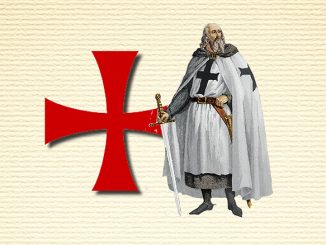
Above: Representation of the Skull of Sidon
The skull and cross-bones, have long been believed to have Templar and Masonic connections and although it has been claimed that the symbol was used on Templar and Masonic grave sites in the past, the emblem was far from exclusive to these two organizations. The skull and cross-bones are universal symbols of man’s mortality. This image of mortality certainly plays a role in Freemasonry. One of the more peculiar legends associated with the Templars involves a skull.
It is well known that the order of the Templars was monastic in nature and therefore forbidden to have involvement with women as shown in the Templar Rule of Order. The legend of the “Skull of Sidon” claims that one Templar knight had a relationship with a woman who died. He dug up the woman’s corpse and consummated their relationship resulting in a most grisly birth nine months later.
“A great lady of Maraclea was loved by a Templar, A Lord of Sidon; but she died in her youth, and on the night of her burial, this wicked lover crept to the grave, dug up her body and violated it. Then a voice from the void bade him return in nine months time for he would find a son. He obeyed the injunction and at the appointed time he opened the grave again and found a head on the leg bones of the skeleton (skull and crossbones). The same voice bade him ‘guard it well, for it would be the giver of all good things’, and so he carried it away with him. It became his protecting genius, and he was able to defeat his enemies by merely showing them the magic head. In due course, it passed to the possession of the order.”
The Holy Blood and The Holy Grail by Michael Baigent, Richard Leigh and Henry Lincoln
According to these same authors this tale can be traced back to a twelfth century author named Walter Mapp, an early chronicler of Templar history. Although the story at that time was not connected with the Templar Knights, by the time of their trials, 1307-1314 CE it was well woven into the Templar legend. In fact it was called upon during the actual trials of the Templars.
Edward Burman in his book “Supremely Abominable Crimes” tells of an Antonio Sicci, an apostolic notary from Vercelli, Northern Italy. Sicci recounts to the inquisitors the tale of the Lord of Sidon, which he claimed he learned while working for the order in the Holy Land. His accusation and recounting of the tale is similar to that quoted in Baigent and Leigh’s book.
As loony as this tale seems to modern eyes, it was easily bought during the period. The inquisitors and theologians would have picked up on the fact that the woman of the piece was Armenian by background. This they would have connected with the Armenian Church and its Paulician sects. The Paulicians and the Bogomils were practitioners of Catharism, which the church had all but wiped out during the Albigensian Crusade. Since the church believed the Cathari to be practitioners of the Black Mass and necromancy, the woman’s Armenian background would make the story a matter of guilt by association.
About Us
TemplarHistory.com was started in the fall of 1997 by Stephen Dafoe, a Canadian author who has written several books on the Templars and related subjects.
Read more from our Templar History Archives – Templar History



